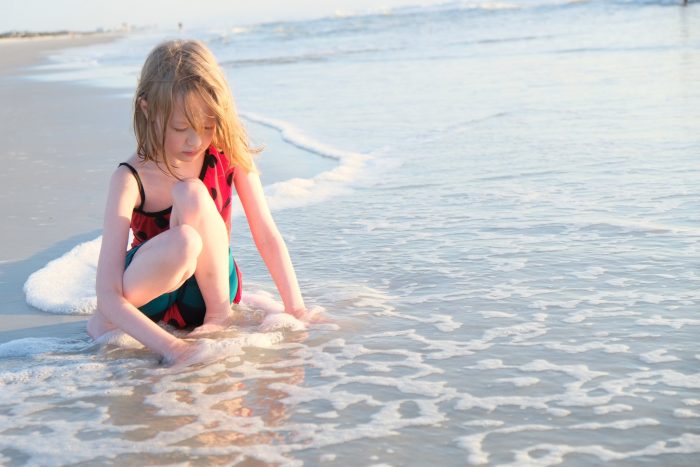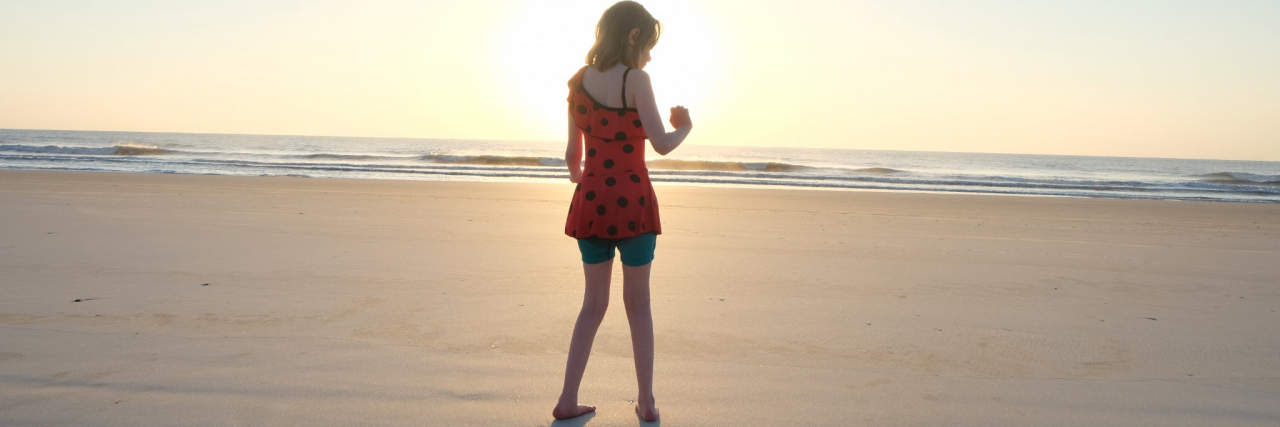Cady walks out of the school gate holding onto an adult’s hand. Legs wide apart and feet in-turned, her gait is the first giveaway to a casual observer that something is not quite ‘right.’
Her neutral expression shifts when she sees me; maybe not enough for someone else to notice it, but I see it. A hint of a smile on the corners of her lips. A widening of her eyes.
As she gets closer to me, her reaction becomes more obvious: her free hand begins to flap and she takes on a literal bounce in her step, her knee bending deeply and springing up with each stride. Just before she reaches me, she lets go of her teacher’s hand and walks the last few steps to me on her own. Though she doesn’t hug me back when my arms wrap around her — her arms don’t seem to work that way — she leans in, letting me know she’s glad to see me too.
“Did you have a good day at school?” I ask her. “Did you have a lot of fun?”
There’s no reply. There’s never a reply, but every day, I ask her anyway.
Turning towards home, she tugs on my hand to encourage me to sing her favourite walking song. Music is her greatest love, and as soon as the first words leave my mouth, a wide smile spreads across her face. At that moment, nothing in the world would make her happier.

Cady is one of just over 100 people around the world diagnosed with HNRNPH2-Related Disorder. A single-point gene mutation on the HNRNPH2 gene affects her body’s ability to splice RNA properly, meaning messages within her body often get garbled or aren’t delivered at all. Every single part of her development is affected by the neurodevelopmental disorder.
Since the significance of the gene was discovered in 2016, researchers have been studying the genetic mutations and looking for ways to help people like Cady. One of these treatment options has reached a pre-clinical trial stage, where the treatment has been developed and is being tested to see how safe and effective it is before beginning a clinical trial with human patients.
It’s very exciting, and also a little bit terrifying.
With clinical trials comes an important question for parents like me, with children who are unable to make these kinds of decisions for themselves: will we sign her up to take part?
Like most decisions we’re faced with in the world of unknowns that comes with a rare disease diagnosis, there’s no clear answer. There are pros and cons we’ll need to weigh carefully before making a decision that might affect the rest of Cady’s life.
In the ultimate best-case scenario, the treatment does exactly what the researchers hope it will do. It will correct the defects in RNA splicing, allowing her body to function in the way it was always meant to. We’re under no illusions that it will be an instant cure, but we have reason to believe that it could make a very significant difference.
The disorder presents on a spectrum, with some patients more affected and others less. While the reasons for this aren’t fully explained yet, it seems to have something to do with how many of a patient’s cells are affected. Cady can walk, unlike many of the other affected children and adults. She doesn’t suffer from the anxiety that many of the others do.
On the other hand, some patients do develop verbal speech. Their vocabulary is limited and their speech patterns are unusual, but they can communicate verbally. Cady is not one of them. In her 10 years, she has never said a word.
She does communicate, in her own ways. Most significantly, she uses an AAC device to answer basic questions, but she hardly ever initiates communication with us. If a treatment could give her the language and the ability to communicate, to express what she wants or feels or thinks, it would be life-changing in a way I can’t even fully comprehend. It would completely change our conception of who she is. It would finally let us get to know her.
We have to consider, though, that an increase in intellectual capacity could also lead to other changes. At the moment, she’s completely unaware that she is different from others. She exists in her own world in a lot of ways, untroubled by so much of what other children her age worry about. My brother once told me that she’s the happiest, most contented person he’s ever met. How much of that peace that she seems to have now will be disturbed if we change the functioning of her body?
There are health concerns as well. Seizures are common in our patient population. At 5 years old, Cady had a series of status epilepticus seizures that required emergency intervention. An official diagnosis of epilepsy followed, along with medication that, thankfully, keeps the seizures in check. Orthopedic issues are just starting to rear their head as she approaches puberty; scoliosis and other bone alignment issues are another common concern among HNRNPH2 patients.
From a health perspective, we want her to be as healthy and as safe as possible, so if treatment would help with that, we want to provide it for her. However, participating in a clinical trial with an untested treatment carries its own risks. No matter how many tests are done ahead of time, no one can entirely predict what will happen when the treatment is administered to a human being.
On top of that, the method of administering the treatment can be dangerous. Recent clinical trials on a different condition using a similar treatment method to the one being proposed for HNRNPH2-Related Disorder led to the development of a different, separate medical condition and, in one case, may have contributed to the subsequent death of the patient. I read the sobering news with a heavy heart, both unable to imagine the pain that family must be dealing with, and simultaneously able to imagine it all too well.
In the end, the choice to participate or not is a deeply personal one, and each family will need to reach their own decision. I have the utmost respect for those who will decide to enroll their child, and also for those who decide not to.
The day is coming when we will be asked to make that decision for ourselves, and although I know it won’t be easy, I know what our answer will be. There’s one dream I can’t shake, one hope that stays with me each and every day.
One day, Cady will come over to me at the end of her school day. “Did you have a good day at school?” I’ll ask her, and whether the answer is yes or no, something truly amazing will happen.
She’ll answer me.


